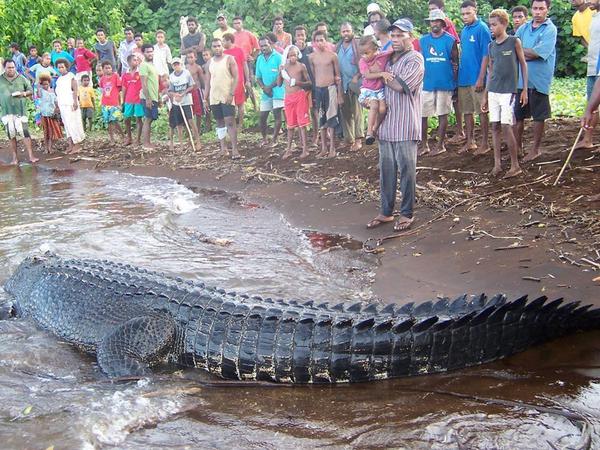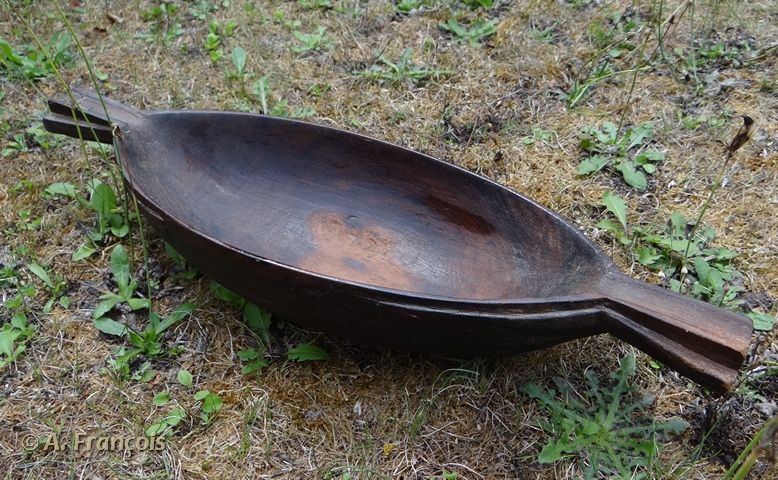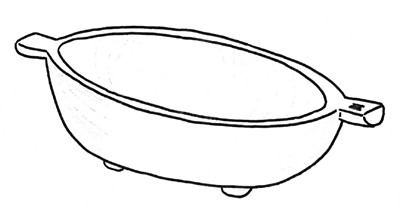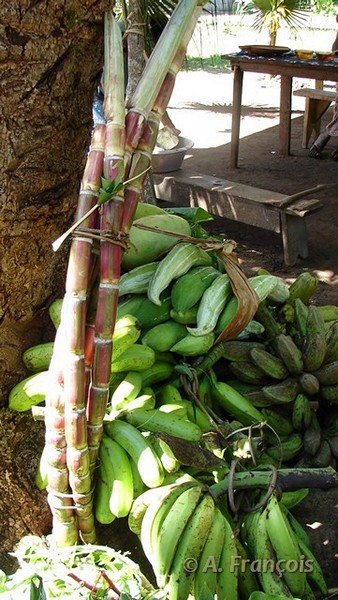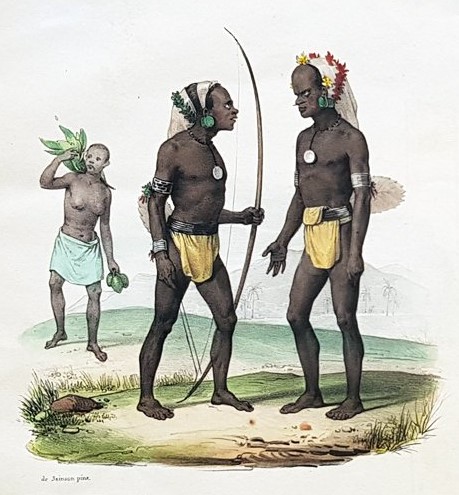Grammar
1 – clause-final, following pronoun or demonstrativefocus marker on deictics: this one, that one
| Ini ta!That's it! |
| Dapa gete 'none na ta ene!My boys, here they are! |
2 – following demonstrative with temporal valuefocus marker for time: now or then (and not any other time)
| Katae ka ni-e na ta!Today is my first day eating this! |
1 – plant+grow spontaneously
| None pon, ini ñepe pe i-ta, pe li-wowo tae.This kind of tuber grows spontaneously [by itself], it is not planted. |
~tabau (i·)taᵐbau
Bsecond verb, intransitive
resultative construction(do V) so as to make s.th. fall; bring down
| I-romo vilo iote wako, i-toe i-tabau.When he sees a tree that fits, he chops it down. |
| Ngiro i-aka ponu ra ka i-vokoiu wolowolo pon, i-vokoiu ka i-tabau.The hurricane blew so hard that it destroyed the cross, and brought it down. |
1 – carry ‹child+› above o.'s belt, i.e. in o.'s arms or on o.'s shoulders
| Ini i-aiu i-ka i-le i-koie i-tabe pi' iape.She came into the room and took (the baby) in her arms. |
| I-tabe apali ne bisa, ñe namolo.She's carrying her child on her shoulder, using a cloth. |
see lexical list at~labu
| La-tabe voko la-lui.They picked up some stones and carried them away (in their arms). |
| Dapa kula ka li-le li-toe longe ne ngogoro ka li-tabe li-kamai ne moe.Some men went to cut firewood in the forest and brought it back home (on their shoulders). |
| Ni-tabe mana luro.I'm carrying some rice (on my shoulder). |
tabo1 taᵐbo particle
Cf. ~tabo ②
rareprecedes verbagain
| Labiou tae, dapa ka tabo li-ke li-ka.After a moment, again they came out. |
MorphologyThe particle occurs at the same place as the auxiliary-like verb form ~tabo ②, except it does not take verbal prefixes.
Averb, intransitive
repeat, say again
| I-kae? Mou, u-tabo!What? Come again! |
| I-tabo!when transcribing[let it repeat!] Play it again! |
Bauxiliary
Grammar
1 – commfoll. by verb V2, with same subjectrepeat doing s.th., do again
| Le-tabo le-le.[we repeat we go] Let's go there again. |
| La-tabo la-teli utele i-le la-wo enga temaka.Alright, let's start listing the placenames again. |
| Kape ne-tabo ne-le metele iote pe kape i-ka na.I'll go again next month. |
| Revo i-tabo i-ma.It's low tide again. |
| Ni-tabo ni-mui.I've forgotten again. |
| A-ko u-tabo u-vongo?Do you want to eat more? [lit. to repeat eating] |
2 – sometimpersonal 3sg, with non-verbal predicatebe again
| I-tabo dapa Iura.+ noun phraseIt's (a photo of) the Vanuatu people again. |
| Menu emele ie teliki i-tabo sa-pine.The chief's daughter is pregnant again. |
| Taluaito kape i-padi basa ini: ne to ne, koro; ne lava tilu, kape bworo. Awoiu kape i-tabo koro pwo mijaka.The (heathen) priest would paint his head: white in the middle; black on each side; and then, a bit of white again underneath. |
tabuluburi taᵐbuluᵐburi noun
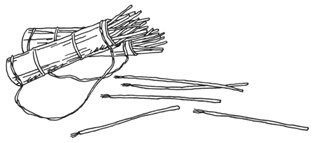
see lexical list atvisone
Quivers ✧ tabuluburi
Tabuluburi, tonge iote pine pe li-loko puro i-koie ene. Li-akawo tabuluburi ne adie idi, puro i-vio ene. Basavono po le-ko li-ago idi, li-katei i-ke ka li-iui.
A quiver is a long sheath where you can insert your arrows. You hang it on your shoulder, with arrows inside. When you want to shoot someone, you draw out an arrow and shoot.
Anoun
Mythology
1 – ancestral spirit, representing the soul of an ancestor. These anonymous, invisible spirits haunt the island and live around humans
| Nga u-le, ata tadoe kap' i-ejau bas' eo mumule.If you go there, the soul of spirits can make your head go crazy. |
| Dapa na ngatene nga tevie mwaliko, tevie nga li-romo nga tadoe.Tamate masksThese are special creatures, half man, half spirit. |
| Idi mwaliko li-tamava se tadoe, li-klasi li-ko kape le-le le-pinoe. Tadoe i-ka i-koie i-mako samame dapa me li-ejau makone korone.The men invoked the spirits, and told them they were going to dance. The spirits came in and began dancing with them, which gave power to the dances. |
2 – sometused metonymically for the bush, the wild, e.g. for certain plant names when they are not fit for human consumption and belong to the forest
3 – representation of spirits through sculptures or headdresses
| makone iadapa tadoedance of the spirits |
seetamate
4 – deity, ancestral god worshipped in ancient times
| Li-puie li-kilasi tadoe adapa.They were addressing their god(s). |
| Tadoe adapa pon, enga ini Vilisao.That god of theirs was called Filisao ‘Tornado’. |
poss. classifierenaka
Aparticle
Grammar
1 – final position in verbal clausenegative particle for realis contexts: ‘not’, ‘does not’, ‘did not’ (opp. metae, irrealis negation)
| Ene ni-mede kaipa tae!I'm not lying to you! |
| Pi’ one i-vete tae.My grandfather never told me. |
| Ka ni-lengi ni-ejau tae.storyI didn't hear it properly. |
2 – final position in non-verbal clausenegative particle for non-verbal predicates: ‘is not’, ‘was not’
| Ero tae.+nounIt's not water. |
| Pon kaiawo tae, ova revo.That's not smoke, that's steam. |
| Somu tae.+adjectiveIt's not far. |
| labiou tae not long after that… |
| Tae, ini tae. Iote teve.+free pronounNo, it's not her. It's someone else. |
Bpredicative
Grammar
1 – clause-final, following the subjectNegative existential: ‘there is no X’; be lacking, be absent
| Ero tae.There's no water. |
| Ka nganae kape li-lengi melia dapa ñe tae, nganae pe kape li-ajau ñe ma dapa tae, nganae pe kape le-la tae.in ParadiseThere's nothing that can bring them pain; nothing that they must do with their hands; no work they have to do. |
3 – to no avail; in vain
synonymmetae ⓑ
ka… tae construction
no longer, not any more
| Ka i-mo tae!accident+He cannot speak any more. |
| Ini ka emele aplaka tae, ini ka momoso iote.She's not a young girl any more, she's become a woman now. |
| Basavono na, kuo demene ka l-ejau tae.These days, outrigger canoes aren't being made any more. |
| Ka tae.existential predicateThere's not any more. / It's over. |
derivativekatae
Takole takole
Takulalevioe
proper noun
Mythology
“Takulalefioe”: name of a deity, mother of the tamate creatures. Variant name of Takulalevioe
takoli takoli interjection
taluaito taluaito noun
Vaeakau-Taumakotaulaituseer, prophet, shaman
Modernity
2 – medical doctor
| Taluaito i-la tongolukilo i-mini men' one.The doctor gave some medicine to my child. |
synonymdokita
linker between tens (or hundreds) and units
| kwa-teva tamana tuaforty eight |
| rea iune tamana tidione hundred and nine |
| uie kwate tamana iunepage thirty one |
| Ebieve iono tivi? – Uluko tamana teva.How old are you? – Fourteen. |
see lexical list attivi
tamate tamate
Motatamatedead person; soul, spirit; ghost; headdressPNVanuatu*qata-matedead person
Aproper noun
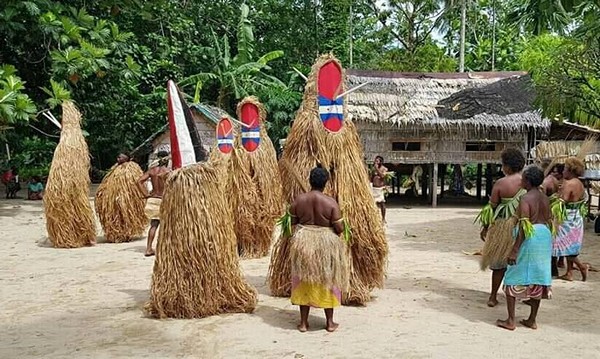
Names of the Tamate spirits ✧ Enga Tamate
| Takole ; Takulalevioe | the Mother of Tamate |
| Mata Tilu | Two Eyes |
| Mata Teva | Four Eyes |
| Aele Teulungo | Pillow Legs |
| kolokolo | Chest Plate |
Mythology
a high-profile Spirit that comes out in villages during ritual dances and important celebrations
Hist.This cultural practice was historically borrowed from the Banks islands (iura) further south – an island mythically called Veluko.
Bnoun

| Temaka etapu, temaka pe li-tamava ene.A sacred place is one where people carry out their worship. |
| Idi mwaliko li-tamava se tadoe, li-kilasi li-ko kape le-le le-pinoe.The men invoked the spirits, asking them the right to perform the ritual dances. |
Synt.The object constructs with the oblique preposition se.
bad
4 – in a bad state; out of order, damaged
| Ni-lengi tamwaliko.I don't feel good. |
| Otovo iupa ka tamwaliko.dynamic readingOur roofing has been damaged. [lit. has gone bad] |
| Li-atevo piene peini toñaki ie Laperus pe tamwaleko.Let's tell the story of how Lapérouse's ship was destroyed. |
Bpostverb
henceIntensifier: very, tremendously
| Ni-bisi tamwalikose ñei!I'm very surprised by this. |
main entrytamwase
Cf. tamwalikose
1 – intensifier: very much
| Awa ene i-viaene tamwase!I absolutely love it! |
| Labiou tamwase kia ka la-lengi kia tae.We haven't heard from each other for a very long time. |
| Awis pine tamwase.Many thanks (for your attention). |
| Ne-ko ne-romo tamwase!I'd really love to see it! |
3 – sometespecially, particularly
| Dapa tadoe li-ejau idi li-madau, tamwase ne bwogo.Ghosts scare people, particularly at night. |
4 – often
| Dapa wopine na li-vete piene ne “ebele ini!” tamwase, pe li-ko motoro.The elders very often use this expression “it's wonderful”: they find it an elegant word. |
seemoro abia
Tanema: a tribal area in the south of Banie island, historically the homeland of the Tanema language
| piene adapa Tanemwathe language of Tanema |
Hist.That area is now inhabited by Polynesian settlers from Tikopia (Tekupie).
synonympiene adapa Tetawo
Tanevio tanefio placename
Geo
Malaita, an island located further west, in the main Solomon Islands chain
| dapa TanevioMalaitans |
POc*tanoq
Anatomy
2 – face
| Ka vitoko kape i-abu tanoma ini, ia i-abu i-kovi.He nearly hit her face; but he missed. |
synonymnoma ① ⓐ▻①
Tangteala taŋteala proper noun
Mythology
Tangteala, god of Arrows and Tornadoes: a god of destruction
| Tangteala, ini tadoe pe i-ago idi ñe diro ka ñe vilisao.Tangteala is a god who strikes people with darts and tornadoes. |
| Viko iadapa nga pon, i-la i-teli teve Tangteala pon.They took their ritual money, and made an offering to Tangteala. |
POc*taliŋa
~tatale (i·)tatale verb, intransitive
walk
| Menu na, ka i-lubi ini i-wene ne sa me i-tatale.This child is able to flip and lie on his belly, (soon) ready to walk. |
see~vilu
~tatawoe (i·)tatawoe verb, intransitive
damaged, broken
| Pele iono i-tatawoe ne temaka ene, ka ere.Your fishnet is damaged here, and there. |
~tate (i·)tate verb, transitive
lay ‹mat› on the ground
| Kape i-la mawene i-kamai i-tate.She can take a (coconut-leaf) mat and lay it on the ground. |
1 – burn ‹s.th.›
| I-ium’ i-le, i-tau uro i-wene ne basa kuo iape teve tilu pon.magic on a canoeFirst, he will burn some charcoal and rub it onto the two ends of the canoe. |
synonym~su ①
Techniques
2 – espburn ‹land›, set fire to the ground – a slash-and-burn technique to prepare a garden for planting
| Li-tau sekele ponu awoiu, moro iote li-le li-teli avtebe.Once they had burnt their gardens, the next day they planted some taros. |
synonym~su ①▻③
3 – freqcook ‹food›
| Ne-tau namuko enaka ne-kae?How will I cook my fish? |
| P-ae jebute, me pe-tau me p-e!Dig out some taros you can cook and eat! |
synonym~apinu
~tavali (i·)tavali verb, intransitive
2 – sunset: go down in the sky, during late afternoon
see lexical list atmoro ①
be sick
| I-tavie mijaka.She's a bit sick. |
| Kasule, li-ovei pe l-ejau ñe idi pe li-tavie.medicine leavesSome vines are useful for sick people. |
| I-ko i-la abo ne kaipa i-ko i-romo abo i-ko pi-tavie we tae.He wants to draw your blood and examine it to see if you are sick. |
tavsone tafsone
tavisone
noun
sickness
| Tavsone ponu i-abu nengele idi.Covid-19That sickness weakens the body. |
te2 te particle
POc*toka
Averb, intransitive
1 – s.o.sit, be sitting
| U-abu u-te u-ka!Come sit down here! |
| Bara ba-te ba-botongo okoro ponu.I'm afraid you may be sitting on my knife. |
2 – gens.o.be located somewhere, whether sitting or not
| Dapa gete li-te ne Toplau.The boys are in the Men's House. |
📘 Inanimate subjects would take ~wene.
3 – s.o.remain, stay
| Ka u-te!greetingGood bye! [lit. you're staying!] |
| Mwaliko iune na ka i-te.There's only one man left (who can speak the language). |
5 – foll. by locativedwell, live
| dapa pe li-te ne kulumoe nathe people living in this village |
| Ini i-te Franis, ia ebele kulumoe iape Japan.She lives in France, but she is actually from [lit. her genuine country is] Japan. |
Teanu, the northeastern island of the Vanikoro group; homeland of the Teanu language
| piene adapa Teanuthe language of Teanu |
📘 Nowadays, the island has only one inhabited village: Puma.
tebekuma teᵐbekuma noun
Artf
k.o. round basket, coarsely woven with coconut leaves, and used to carry food
see lexical list atuie luro
tebelia teᵐbelia noun
side of a ship
| I-ka i-ka i-avo ne tebelia.[the ship] came drifting on its side. |
tebene teᵐbene adjective
plant, animalof a pale or yellowish colour
| kie tebene variety of Pandanus with yellow leaves |
| kava tebene variety of kava of a pale colour |
| bwoe tebene type of shark, pale-coloured |
Polynesiante ipu
1 – cup made out of a coconut shell
| viñe teipua coconut shell |
| Li-ovei pe li-la tepulu li-lateli ne teipu me le-su nga buluko.Kauri resin can be stored in an empty coconut shell, and lit as a lamp. |
synonymwabwaero
~teiu (i·)teju verb, intransitive
bow down, lean down
| I-abu i-vio ponu ini i-ko i-teiu me i-tabe.As he fell on the ground, (his mother) bowed down to take him in her arms. |
tekate tekate noun
Polynesiante kete
Techniques
k.o. round basket woven in coconut leaves, used for storing or carrying food
| Vongoro i-koie ne uña tekate i-avo boso iawo, ne kisin.The almonds were inside baskets above the fire, in the kitchen. |
see lexical list atuie luro
tekau tekau noun, relational
Vaeakau-Taumakote kahuclothes, cloth
Artf
trousers
| Ni-vene ne botu, tekau ene i-tawoe.As I climbed on the boat, my trousers got torn. |
tekepu tekepu adjective
Vaeakau-Taumakote kefualbinoPPn*kefulight-coloured hair
albino
| emele tekepuan albino woman |
| Ini tekepu.He's albino. |
tekume tekume noun
a traditional skirt, made out of bark, and worn by women for dance ceremonies
seetolosai
tekumete1 tekumete noun
Cf. tekumete ②
Flora
k.o. seashore tree, whose hard wood is used for several artifacts, incl. tekumete ②Pemphis acidula.
Tekupie tekupie
Tukupie
placename
PolynesianTikopia
Tikopia, an island located east of Vanikoro, home to a Polynesian population who has partly immigrated to Vanikoro
| Dapa li-le Tukupie, tev' iu re.They went to Tikopia, eastward. |
telango telaŋo noun
Vaeakau-Taumakote laŋostick or roller for canoe
log rollers, used to move heavy objects (e.g. canoes)
Artf
‘food basket’: a basket hanging in the kitchen, keeping food
| Telau i-avo boso iawo.The food basket is hanging above the fire. |
see lexical list atuie luro
oil, extracted from certain plants, and cooked
| tele peini lurococonut oil |
| tele peini vongorooil of Canarium almonds |
synonymtemena
telemoe telemoe
telemwoe
noun
Cf. moe ‘house’
| bali peini telemoe pole lying at the base of a house walling, plinth |
| Li-panade okoro awoiu li-si telemwoe peini mwoe.You split the bamboos, and then you make the wallings of your house. |
telepakau telepakau noun
Polynesian*lapakauskilful, crafty
poss. classifierenaka
Anthropology
1 – culture, traditions of a specific place
| telepakau akapaour culture |
| Teliki Makumoso Banie i-waivo idi mwaliko ñe telepakau, ñe maluo.The Elder God Banie instructed humans with culture and life. |
| Ponu telepakau tamwaliko pe noma; ka awoiu.sorceryThat's a bad tradition of times past; it's over now. |
1 – put ‹s.th.› down
~la ~teli serial verb, transitive
take and putput ‹s.th.› down
| Leka, kape u-la ngatene u-mini susuko tae. Kape u-la u-teli, ka ini ka i-la.As for your (opp.-sex) cross-cousin, you cannot give her anything directly. You just put it down, and she'll pick it up. |
contracted to~lateli
2 – bury ‹s.o., s.th.›
| Dapa pe li-abu dapa li-bu, kape le-lui dapa le-teli dapa ne tanoe.Those who were killed were later buried in the ground. |
3 – henceplant ‹fruit, taro+›
| li-teli balaweto plant pineapples |
| Li-tau sekele ponu awoiu, moro iote li-le li-teli avtebe.After burning their garden, the next day they went to plant taros. |
| I-iumu, pi-teli mataña (jebute).First of all, we planted the (taro) shoot. |
| Vivilo li-teli ne netebe.Swamp taros are planted in swamps. |
see~do ①
5 – send ‹message›
| Kape ne-teli mama ene ñ’ eo.I will ask to be engaged to you [lit. I shall put my voice for you]. |
| U-teli mama ene se.Please arrange my engagement with her [lit. you send my voice for her]. |
synonym~nabe▻④
synonym~vi nuduro
Vaeakau-Taumakote alikichief, paramount chief
pluña telikidapa teliki
1 – chief, leader of a community
| Uña teliki li-anu i-dai i-le i-le.The chiefs drank the kava around (in a circle). |
| menu emele ie teliki[child female of chief] the chief's daughter |
| Teliki iadapa i-vete ngapiene.The chief proclaimed the opening of the Festival. |
| Uña teliki li-lamini tanoe se dapa.The authorities granted them some ground. |
Teliki Makumoso teliki makuˈmoso proper noun
Anthropology
1 – elder chiefparamount chief, supreme chief
| Teliki iadapa pe li-maluo, ka Teliki Makumoso iadapa po li-bu.The living have their chiefs; the Dead have their own supreme chief, “Teliki Makumoso”. |
Banie, the Supreme Lord ✧ Banie, Teliki Makumoso
Basavono po kulumoe i-ta ñei, Teliki Makumoso li-ko “Banie”. Ka Teliki Makumoso Banie pon na, i-waivo idi. In’ na, Teliki Makumoso, ai’ akapa, i-waivo idi ñe telepakau, ñe piene; i-waivo idi ñe ngatene pe li-ajau: nga ebele ko i-waivo idi pe li-vo mwoe, i-waivo idi pe li-bo vilo, kuo, wele, ngaten’ abia pon na.
When our country emerged, our Supreme Lord was called “Banie”. This supreme god was the one who taught everything to humans. He's the one – our Supreme Lord, our father – he's the one who taught us our culture, our language, everything we do: thus he taught us how to build houses, how to create things with wood, how to cut canoes, how to make paddles – all those things…
~telini (i·)telini verb, transitive
+ nounturn into, transform into ‹s.th.›
| Moe iape ka i-telini voko.His house has turned into stone. |
~teli utele (i·)teli.utele verb-object idiom
~teli ‘put down, plant’ + ‘tree base’
plant a (tree) basebegin, start (to do, me + Irr.)
| Ni-teli utele buro.I began a song. |
| La-tabo la-teli utele i-le la-wo enga temaka.Alright, let's start listing the placenames again. |
Morphology~teli utele is often contracted as ~tetele*, with the same meaning.
see~tetele
Polynesiante lupePacific pigeon (Ducula pacifica)
| mwoe ie telupea pigeon’s nest |
| La-le lai-ago telupe?Shall we go pigeon-hunting? |
| Pe li-wete telupe, u-avi visone ka u-iui diro i-le i-wete ini.When you hunt pigeons, you bend your bow, and let the arrow fly and hit it. |
(?) Polynesian*makastone, rock
Geo
2 – esplocation on land, geographical spot
| enga temakaplace names |
| Temaka etapu, temaka pe li-tamava ene.A sacred place is one where people carry out their worship. |
| Li-kila temaka pon li-ko “Moe ma Tadoe”.That place is called “Devils' Lair”. |
| Dapa le-ko le-romo temaka pe noma.archaeologistsThey want to see villages from the past. |
3 – sometearth, ground
| Bai-te ra ra ra, ba-lengi temaka pe i-ekili.earthquakeWe were at home, when we suddenly felt the place tremble. |
synonymtanoe
4 – subject of impersonal predicatesthe universe, insofar as it is subject to the diurnal cycle. Dummy subject for various predicates for weather or times of the day
| Temaka mamote nedemo we ka tomoro?Is it still dark? or is it daylight already? |
seevono ②▻⑤
temotu temotu noun
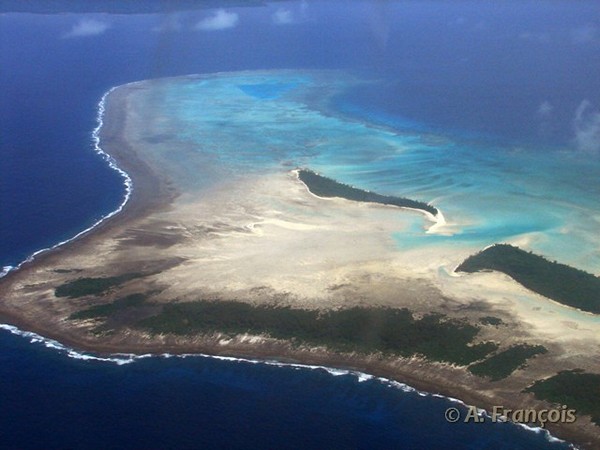
Polynesiante motu
Geo
islet, small island
| Li-te li-wamu dapa li-te ne temotu ne Vilimoe ponu.Lapérouse sailorsThey went to hide in the islet of Filimoe over there. |
temounu temounu noun
Vaeakau-Taumakote mounu
bait
| Namuko i-ka i-e temounu mina kangele teuko enaka!The fish came and ate away the bait from my fish hook! |
Temwo temwo
Temuo
placename
Geo
Temwo, one of the main villages of Vanikoro, located southeast of the main island Banie
tenuro tenuro noun
1 – thick fibres composing the husk of a coconut
seelabaro
Coconut-fibre rope ✧ tenuro
Tenuro pon, li-kai mina labaro li-tuku ne revo i-vagasi metele iune. Awoiu li-tabo li-loko li-koioi li-tate iwene ne ole me kokoro ne aeve. I-le i-le pon, basavono po kokoro pon, li-loko pon li-vei me ika nga tenuro. Li-ovei pe li-ejau ngatene abia ñei, ebele nga pele peini namuko, we taka pe li-koene ne aele idi.
To make a rope, you tear off the fibres of a coconut husk, and plunge them in the sea for a whole month. Then you collect them again, bring them ashore, and extend them on the sand so it dries in the sun. Once it's dry, it can be woven into a rope. You can then make several things with it, like a fishing-net, or sandals.
Techniques
2 – rope, traditionally made by braiding together coconut fibres
| Dapa noma vana li-apilo tenuro.People in the past used to make coconut-string ropes. |
| Kape li-odo tenuro me le-vo ñe nengele kuo korone.We'll look for a rope so we can attach firmly the elements of the canoe. |
synonymtero
POc*taŋis
tears; the act of crying
| Tengiro i-pu i-abu.His tears were running down. |
| Awoiu, menu ka i-re tengiro, ka i-ekeke.The child stopped crying [he released his crying], and laughed. |
see~etengi
tepakare tepakare noun
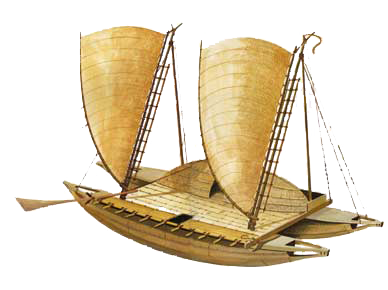
Naut
1 – Polynesian catamaran: a double-hulled voyaging canoe
| Toñaki ie Laperus ponu, ae, tepakare. Lovia tilu, ne?Lapérouse's ship, you know, it was a catamaran. With two sections, you see? |
tepao tepao noun
(?) Polynesianpaostrike, hammer
Techniques
1 – spear, harpoon
| U-la tepao u-ago ñe namuko pon.You spear the fish with a harpoon. |
synonympwene
tepapa tepapa noun
Polynesiante papaplank, board
Anthropology
2 – espstomping boards. During ngapiene festivals, a blateno pole is erected in the middle of the village area (mane). Laid out in circle (~dai, ~dadai) around it, are a number of wooden boards half buried (~iu ②) in the ground, on which dancers leap and stomp (~viaene, ~wate) during the celebrations, in a loud and joyful dance.
| Li-wate tepapa, li-viane tepapa ponu; ka li-pinoe pon ta ka li-mako.They were hitting the boards, stomping on the boards: such was their dance. |
The stomping boards ✧ tepapa
Tepapa, li-toe kara nebe li-bo nga kulaña metele. Awoiu li-ae tanoe li-la tepapa li-botongo ñi. Awoiu idi li-mako ne pongo li-viane me aña ini.
‘To make a stomping board, you cut a root of rosewood tree, and carve it in the shape of a semi-circle. Then you dig up the ground, and cover the hole with the board. Later, people will dance upon them, stomping for the noise it makes.’
tepuke tepuke noun
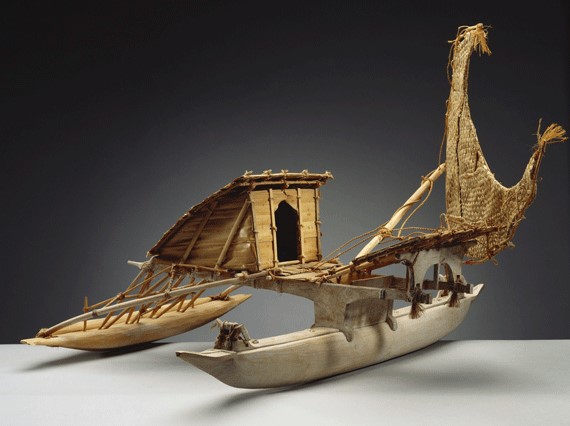
Vaeakau-Taumakote pukebig traditional canoe for long sea voyagesPPn*pukebow and stern decking of a canoe
large sailing canoe used by the Polynesians for ocean travel, characterised by its decking and cabin
| Tepuke ponu, kuo pine; moe aplaka pon, ne pongo kuo pon.The ‘tepuke’ ship is a large canoe; it has a small cabin, on top of the ship. |
| Li-ovei pe li-pwalau li-le Iura ne tepuke.They used to travel to (north) Vanuatu on their large canoes. |
| Ei! Dapa! Na toñaki ae na? Na toñaki we tepuke?Hey, people! What sort of ship is that? Is it a European ship, or a Polynesian sailing canoe? |
tepulu tepulu noun
Vaeakau-Taumakote puluglue, gumPOc*ᵐbulut
resin, gum ‹of tree›: sticky stuff that comes out of a tree, after it has solidified
Kauri resin ✧ tepulu
Basavono po li-toe oie dero, abwa i-ke mina. I-ka ra ra i-beiu ka li-kila li-ko “tepulu peini dero”. Li-ovei pe li-la tepulu li-lateli ne teipu me le-su nga buluko.
If you cut at the trunk of a kauri tree, the sap comes out; when it hardens, we call it tepulu, “kauri resin”. Kauri resin can be stored in an empty coconut shell, and lit as a lamp.
tepungo tepuŋo noun
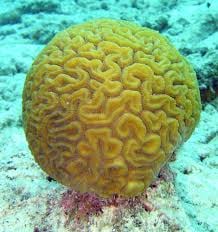
Vaeakau-Taumakote pungasmooth, big, round coral stone
| Tepungo pon voko wopine li-karau ne mwoko ka uña viko me komudo li-vio ene.Coral rocks are large boulders that grow on the reef bed, and that's where shells and clamshells grow. |
| Kanamuko me komudo i-lakau tepungo.Clamshells adhere to the coral rock. |
Flora
1 – naturalvine, liana
| li-katei teropull a vine (in the bush) |
| Li-la tero li-dai ñe uie luro.They take a liana and wrap it with coconut leaves. |
synonymveve
~ke ② ⓐ▻③ ‘go out, go seawards’
geocentric directionaloutsideoutside, seen from the interior of the island; hence down towards the shore; seawards
| Le-le tetake ne touro l-oma!Let's walk to the shore and find some seafood. |
| Li-le li-vagas’ ere, tetake n’ adie ngamuli.They went all the way to that point over there – out there towards the ocean. |
| Ngiro Teulu Laki i-aka i-ka tetake ne.from the southern shore of VanikoroThe Teulu Laki (southerly) wind blows from the ocean, this way. |
~koie ⓐ▻⑤ ‘go inland’
1 – geocentric directionalinsideinland, seen from the shore; uphill
| Sekele iaba ene vitoko ne, takoie ne.Our garden is here, uphill this way. |
| Li-koioi li-su buluko ka li-koie li-vagasi takoie.They lit torchlights and led them in, until they reached (the village) inland. |
2 – seen from the seatowards the coast, towards the island
| Dapa kula li-katei noma nuduro tilu ponu, li-koioi tetakoie, i-le i-vene ne moko taniboro.Some people pull the two ends of the scareline towards the shore, to a dry zone. |
| Li-koie takoie ne touro ponu, dapa wopine kula li-ke li-le.While they were walking up towards the shore, some of the [island's] chiefs walked down towards them. |
| Li-ka ne mataiko Paiu ponu, dapa li-te takoie ponu, ne kulumoe pon.As they were [sailing] through the Paiou channel, some men were waiting for them on the coast, on land. |
tetavene tetavene locative
teta- + ~vene
up, on the upper side; uphill
| Li-le li-te tetavene pon, ne waluko ero.They went to stay uphill over there, along the river. |
seeiura
tetawene tetawene noun
Polynesian*tataudesign, tatoo
Anthropology
2 – customary pattern, drawn or painted upon a surface; e.g. frieze-like decorations on the walls of a sacred house (toplau)
| Mata i-katau Toplau na ! Mata i-katau tetawene !Look at the sacred house! Look at the (drawn) patterns! |
| Tetawene kape le-si nga ne –demonstrationThe patterns were drawn like this – |
| Tetawene peini Toplau mwa gete, iote enga ini “ava saba”.Among the customary patterns found on the Men's House, one is called “wings of the frigatebird”. |
(?) tev’ tawo ‘northwest’
ancient village located in the south of Banie, formerly the main village of the Tanema language community
| Noma, dapa Lovono li-ovei pe li-via samame dapa Tawo.The Lovono tribe used to wage war against the Tetawo tribe. |
| Basavono ponu, mamote kulumoe Tetawo mate idi abia li-te ene.At that time, the village of Tetawo was still inhabited. |
Hist.The area has now been taken over by Polynesian settlers from Tikopia.
POc*tolu
three
| Viñe teupu tete we teva, bwara kape votobo eo.Three of four cups, that may be enough for you. |
| E, dap' tete! Pi-ka vele?Hey, you three! Where are you coming from? |
see lexical list attivi
~te teve (i·)te teve verb, oblique transitive
1 – literals.o.be withlive with ‹s.th., s.o.›
| Noma, po apali i-maili i-ven' i-ka, i-te tev' ai' iape me et' iape.In the old days, when a child grew up, he would stay with his parents. |
Tetevo tetevo placename
1 – Utupua island, close to Vanikoro
| La-vesu bavede i-le. I-le, la-koie Tetevo.They hoisted the sail and travelled; travelled towards (the island of) Utupua. |
| Tetevo, piene adapa tete: iote piene adapa Asubuo, iote Nebao, iote Tanibili.Utupua has three languages: one is Asubuo, one Nebao, one Tanibili. |
Polynesiante ukafishing line
fishing line; generic name for the equipment used in angling for fish
| Le-la teuko ne jokoro me le-katei ñe namuko.Let's take our bamboo fishing rod, and go angling for fish. |
teulungo teuluŋo noun
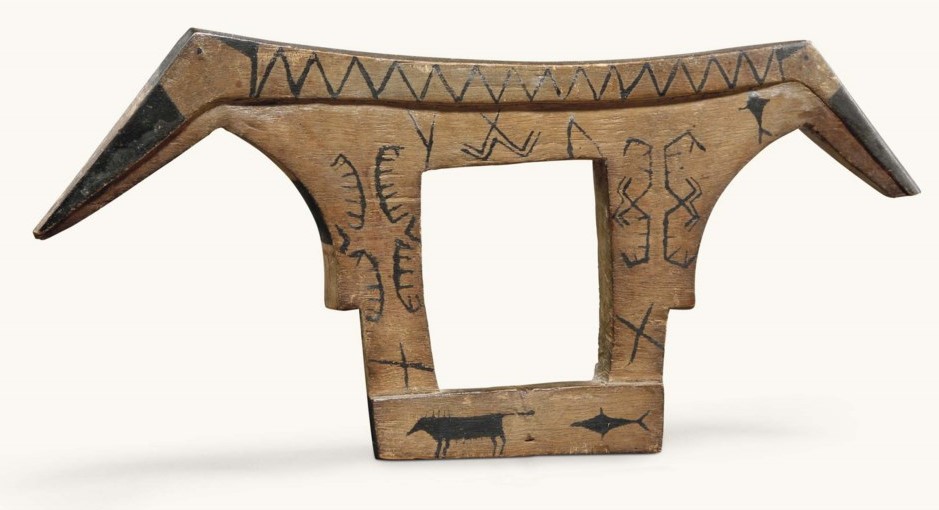
Vaeakau-Taumakote ulungaheadrest, pillow
Artf
1 – headrest: highly valued wooden artifact used for resting o.'s head while sleeping
| Teulungo ie ai’ adapa li-ovei pe li-la nga ai’ adapa i-mini aña dapa.upon the father's deathThe headrest of their father, they can inherit it only if their father has performed the transmission ritual towards them. |
teune teune noun
PPn*te fune
skin disease: scabies, itch, ringwormTinea spp.
| Teune va i-ememe.Scabies is itchy. |
POc*pat
four
| kwa teva tamana tuaforty eight |
| Viñe teipu tete we teva, bwara kape votobo eo.Three or four cups of kava should be enough for you. |
see lexical list attivi
Cf. tevie ‘side’
1 – foll. by Directionaltowards ‹such and such direction›
| Apali pon ka i-vilu i-le tev' iu re!That child ran away in that (upward) direction! |
| Ie da viñevi tev' tawo, ka ie da penuo tev' iu.The [house] for women is downward, the one for men is upward. |
3 – s.o.(stay+) by ‹s.o.›, with ‹s.o.›
| Laperus i-ka tev' kiapa ne kulumoe iakapa Vanikoro.Lapérouse came among us, in our island of Vanikoro. |
4 – after existential verbs.th.be, exist with ‹s.o.›; equiv. of Eng. ‘have’
| Uña ngatene pi-romo na, ngaliko ngatene pe i-ke tev' emel' enone.All those things you're seeing, are things that appeared to my wife. |
| A-rom, na vilo engaiote! Vilo pon i-vio teve kiapa tae.Look at this strange plant! We don't have it (in our island). [lit. That plant doesn't exist with us.] |
5 – (take+) from ‹s.o.›
| Awa ene ni-ko ne-sava teve teliki.I want to buy it from the chief. |
| Li-le li-wamabu teve ai' iape me ete iape.They went to ask (permission) from her parents. |
| Iepiene pon na, ni-lengi tev’ et’ one.This story, I heard it from my mother. |
| Bwara le-ko le-watebo iepiene teve uña dapa wopine.We should rather enquire about those traditional stories from the elders. |
6 – after some stative predicatesdependent on ‹s.o.›, relative to ‹s.o.›; hence to ‹s.o.›, for ‹s.o.›
| vitoko teve eneclose to me |
| Nganae li-ko li-ajau, na i-wene moli teve dapa.Everything they wanted to do ended up being easy to them. |
| Ni-romo viko i-aiae teve ene.I realise that money is a problem for me. |
| Tev’ eo!predicativeIt's up to you! |
4 – topic, issue; regard
1 – (on) the side towardsindicates a direction in space
| Ne moe puo re? – Tae, ne tevie tev' iu i-ka m'jaka.In this house down there? – No; a bit further up [lit. on the side towards up a little]. |
3 – geocentric meaningupwindon the southeast side; south or east
| Kulumoe Iura, kulumoe i-wene tev’ iu.The islands of (north) Vanuatu are located southeast [of Vanikoro]. |
| Ngiro Tangake i-aka i-abu i-kamai tev' iu ne.The Tangake wind blows down from the east. |
| Apali pon ka i-vilu i-le tev' iu re!That child ran away in that (upward) direction! |
1 – lower sidedown, below
| Toplau tilu. Ie da viñevi tev’ tawo, ka ie da penuo tev’ iu.There are two ritual houses. The one for women is located down, the one for men is up. |
contrasts withtev’ iu
2 – geocentric meaningon the northwest side; north or west
| Ngiro Tokolau i-aka i-ka tev' tawo ne.The Tokolau wind blows from the west. |
synonymtawora
~te wako (i·)te.wako verb, intransitive
1 – stay wellbe well, be healthy
| Ni-vodo ni-ko eo ka uña damiliko iono pi-te wako.I hope that you and your children are well. |
tiaume tjaume
tiame
noun
Naut
“canoe notch”: notch carved on each side of a canoe hull, meant to attach a rope when dragging (~katei, ~iui) the canoe on land towards the sea
| Li-toe kuo wako, li-ajau tiame wako, i-viñi dapa gete iape i-ko “Wako le-le le-katei.”Once they had carved the canoe, once they had carved the notches, he told his youngsters: “Alright, let's drag it now!” |
tiei ʧei
tieli
interjection
Cf. tieli ‘brother, sister’
brother, bro! sister! my friend! Commonly uttered to s.o. (espec. male) who's regarded as a friend
| Vonila wako tiei.Good evening, my friend. |
| Ebele piene, tiei.You're right, brother. |
| Awis pine, tiei !Thanks, bro! |
POc*taciyounger same-sex sibling
1stili' one2stilio3stieli
Kin
sibling, of either sex: irregular form of tilio* for 3sg (‘his/her sibling’) and when followed by a noun (‘sibling of X’)
| Tilio, we tieli?anaphoric 3s possessorIs he your brother, or his/her brother? |
| tieli mwalkote[his/her sibling male] his/her brother |
| tieli emele[his/her sibling female] his/her sister |
| tieli eteNP possessoryour mother's sibling |
| tieli StanleyStanley's sibling |
| Emele iote i-ve ini, ka emele iote i-ve ene, da tieli.reciprocal predicateThe woman who gave birth to him, and the one who gave birth to me, they were sisters. |
MorphologyThis is one of the only forms where the sound [ʧ] appears regularly.
1stili' one2stilio3stieli*3ptil’ iapetili’ adapa
Kin
1 – symmetrical termego male or femalesibling of either sex (Z, B)
| tili' one emele[my female sibling] my sister |
| tili' one mwalkote[my male sibling] my brother |
| Tilio emele pe i-katau eo?Is this your younger sister? |
| Tili' one pine, moe iape na ta.My big brother, here is his house. |
Kin
2 – classificatory siblingparallel cousin of either sex (MZC, FBC)
| Tili' one emele pe tieli et' one i-ve, kape ne-kila ini metae, pe keba basa iune.My female cousin, born of my mother's sister, I am not allowed to marry her, because we belong to the same moiety. |
AnthropologyParallel cousins cannot marry together, unlike cross-cousins (leka).
POc*picanhow many
Numbers ✧ Tivi?
| tivi | how many |
| iune ⓐ | one |
| tilu | two |
| tete ① | three |
| teva | four |
| tili | five |
| tuo | six |
| tibi | seven |
| tua ; tilu-tae | eight |
| tidi ; iune-tae | nine |
| uluko ; sangaulu | ten |
| uluko tamana iune | eleven |
| tamana | linker for units |
| kwa-tilu | twenty |
| kwate | thirty |
| kwa-teva tamana tua | forty eight |
| rea | hundred |
| imuo | thousand |
to2 to noun, relational
middle
1 – spatialmiddle; space between two spots
| Li-vo aero i-dai, me kape le-mako ne to.They erected a fence around (the village area), for us to dance in the middle. |
~to3 (i·)to verb, oblique transitive
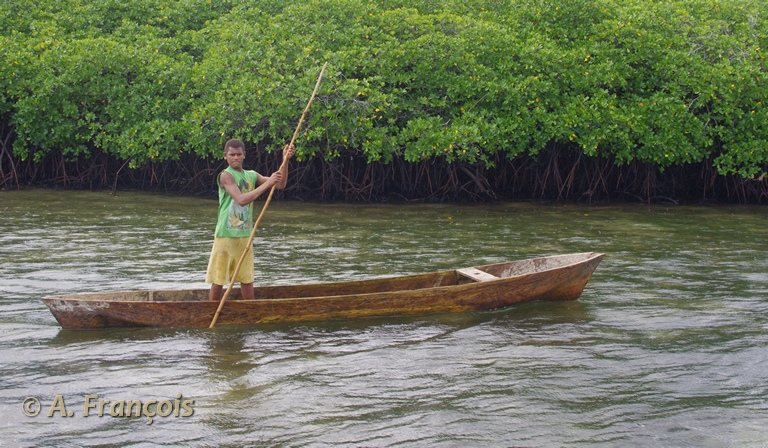
+obliquepole a boat on shallow sea
| I-to ñe kuo iape.He's poling his boat. |
~tobo (i·)toᵐbo
Averb, intransitive
poke out, break through, in the form of a longish object
| Dapa li-romo vilisao ka i-tobo i-ke – li-romo nga luro.They suddenly saw a tornado break through the clouds – it was [long and thin] like a coconut tree. |
Bverb, transitive
1 – press ‹s.th., s.o.› with finger or longish object (stick+); poke ‹s.th., s.o.›
| U-tobo ma ene etapu!Stop poking my arm! |
Cverb, oblique transitive
wave or raise o.'s finger (at s.th., ñe)
~tobo ñei (i·)toᵐbo ɲei
~tobo ñe
verb, intransitive
restrain o.s., remain in the limits of decency
| Dapa kula li-wablei piene, ia li-tobo ñe, pe dapa ie mwaliko po awa dapa i-su.funeral ceremoniesSome people may make jokes, as long as they restrain themselves, with respect to the family who are in mourning. |
POc*taRaq
Averb, transitive
Techniques
1 – cut ‹wood+›, chop, with a knife or axe
| Li-toe dero i-abu.They cut down the cauri tree. |
| Dapa kula ka li-le li-toe longe ne ngogoro.Some men went to cut firewood in the bush. |
| Tepapa, li-toe kara nebe li-bo nga kulaña metele.To make a stomping board, you cut a root of rosewood tree, and carve it (~bo) in the shape of a semi-circle. |
| li-toe selacut the umbilical chord |
derivative~totoe
tokoli tokoli noun
1 – raised wooden platform: elevated passage, bridge
| Tokoli i-dobuo pe tebo, ka i-mu tamwase.lying trunk used as bridgeThe bridge is wet due to the rain, it's very slippery. |
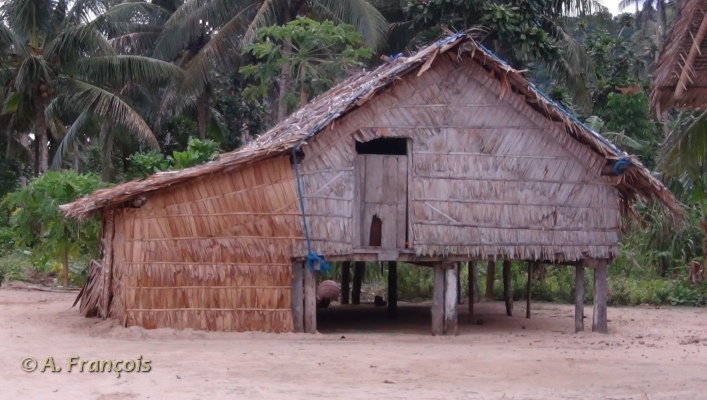
Architecture
2 – espraised floor platform in a stilt house
| iutego kuledi peini tokolishorter stilts for the floor structure |
| wavilo / watogobe peini tokolitie-beams supporting the floor structure |
| pwa tokoli empty space under a house |
📘 The platform supports a floor of wooden slats (tapaia buioe).
lie, say lies
| L-ajau piene pe li-tomoli ñe tanoe.They made up a story to deceive people about land ownership. |
2 – gendaylight, day
| Temaka mamote nedemo we ka tomoro?perfect aspect ka ②Is it still dark? or is it daylight already? |
| Li-mako li-mako, nedemo, tomoro, nedemo, tomoro…They danced on and on, during the night, during the day, the night, the day… |
plantshoot, sucker
| U-la tongo jebute na, me u-kamai me la-lui me la-iu.Take this taro shoot, and go bury it in the ground. |
synonymjie
POc*toŋoRmangrove
Anthropology
1 – “custom leaves”: plants endowed with a special power, whether magic or medicinal
| Jeboro ini tongolukilo iote.Wild basil is (used as) a medicinal plant. |
| Tongolukilo ponu wako peini basa idi i-meli.This medicinal plant is useful against headaches. |
| Mwaliko pon i-labu tongolukilo pe i-ejau ñe idi.That man knows how to perform magic for people. [lit. he holds medicinal leaves…] |
| Dapa noma, uro we tongolukilo peini ngaten’ motoro i-wen’ tev’ dapa.Our ancestors used magic soot and magic leaves for important matters. |
Modernity
2 – hencemedicine
| Taluaito i-la tongolukilo i-mini men' one.The doctor gave some medicine to my child. |
seekunini
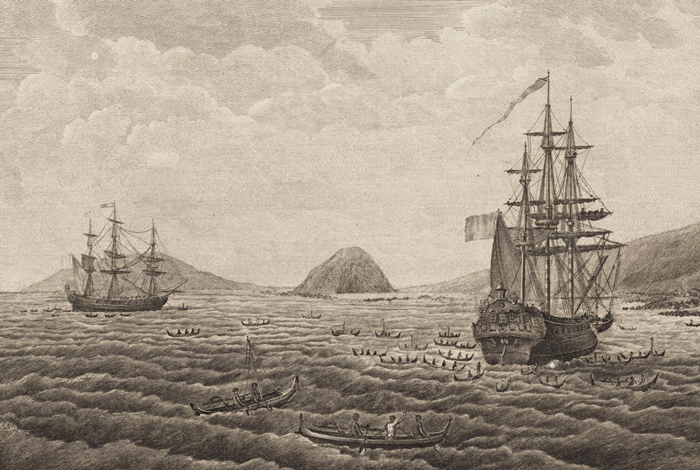
large ship, esp. Western sailing ship
| Ei! Dapa! Na toñaki ae na? Na toñaki we tepuke?Hey, people! What sort of ship is that? Is it a European ship, or a Polynesian sailing canoe? |
| piene peini toñaki ie Laperusthe story of Lapérouse's ship |
| Li-apilo toñaki awoiu, bara i-vagas’ metele tuo nga ponu.The building of the ship must have taken about six months. |
| Vilisao i-ka i-arevo toñaki pon kula tilu na.The tornado split the ship into two halves. |
Anthropology
1 – club house reserved to men, esp. initiated men
| Moe uña dapa gete, enga ini Moe Toplau.The house of young men is called the Toplau house. |
| Teliki, samame dap' wopine, dapa gete, ne toplau; da viñevi, ne mwoe.The chief, together with elders and young boys, can go in the men’s club; but women stay in their houses. |
2 – hencemale initiations
| Ai' iape kape i-la men' iape i-koioi ne Toplau.The father would introduce his son into the Men's House. |
Toplau mwa gete toplau mʷaᵑgete noun
| Ni-ko ne-wasi kaipa ñe Toplau mwa gete na.I wanted to tell you about the Men's Initiation house. |
| Ba-romo Toplau mwa gete pe i-ka mina tanoe pon, i-vio.myth of Toplau mwa geteWe saw the Men's initiation house come out of the ground, and stand in front of us. |
Polynesiante poraplaited coconut leaves
Techniques
k.o. basket for carrying food
| Ni-wo topola 'none ne die 'ne.I'm carrying my bag on my back (hanging on my forehead). |
see lexical list atuie luro
Redup. ~toe ② ‘cut, chop’
chop, cut ‹s.th.› in many pieces
| I-totoe jebute iape.He cut his taro in small pieces. |
| Kava li-totoe, kara i-koie samame.You chop kava to small pieces, including the roots. |
totokale totokale
Motatotoɣalepicture
Anoun, relational
Bnoun
photo, picture (considered as an object in itself); somet. video, TV
| Ene ni-rom ne totokale.I saw it on a photo / on TV. |
Synt.The possessor encoded with the ordinary (alienable) marker enone is the owner of the photo, not its object.
~toulo (i·)toulo verb, transitive
hang ‹s.th.›, hook up
| Li-toulo i-avo, li-toulo ne toñaki apilaka.anchorThey hooked it up upon a small boat. |
tovokowo tovokowo
tevokowo
noun
Techniques
lever: a long, wooden crowbar used to push heavy objects (e.g. a canoe) on log rollers
| Dapa li-ioi tovokowo ene: kuo pine ponu i-atili i-abu i-le.As they pushed the lever, the large ship slid down all the way. |
